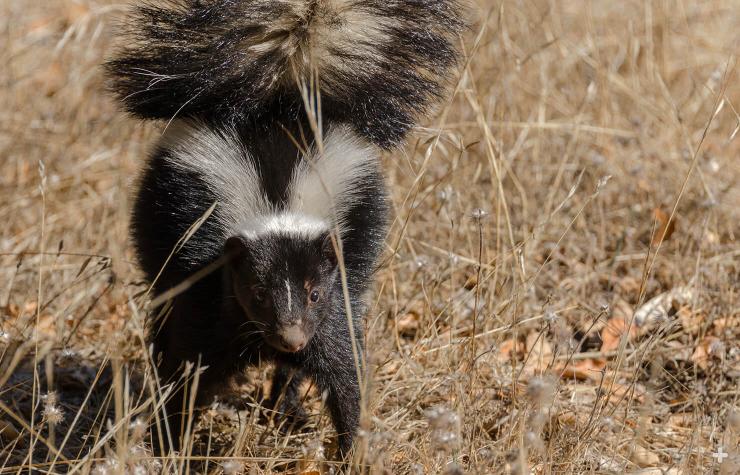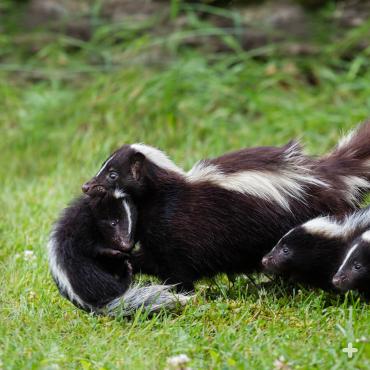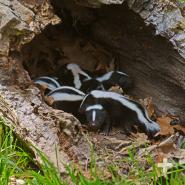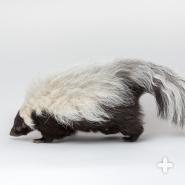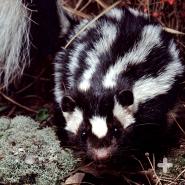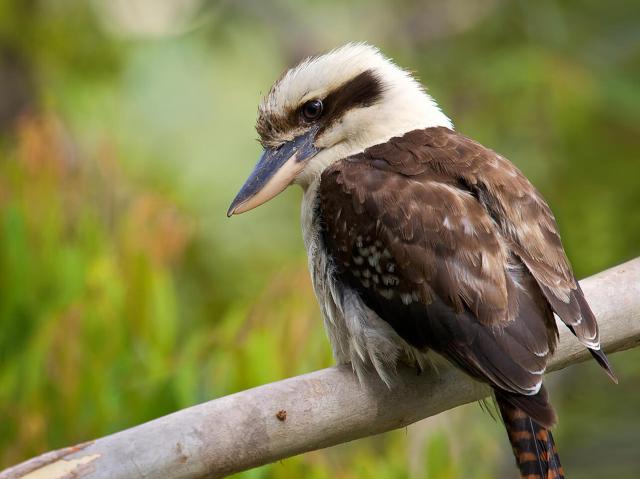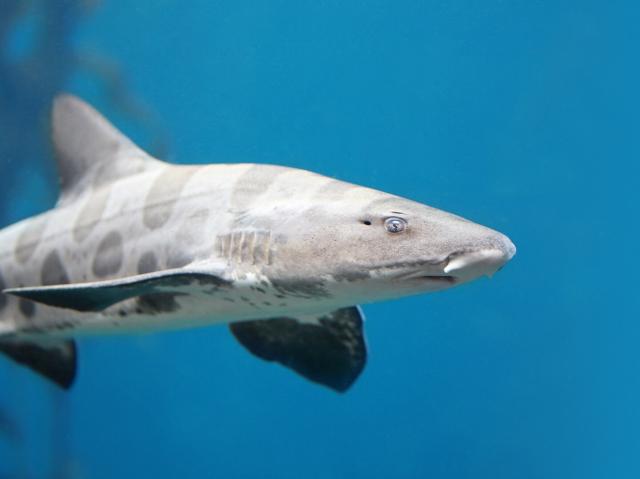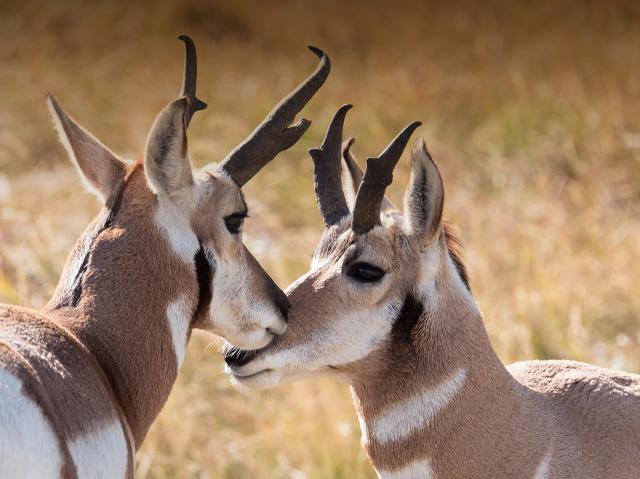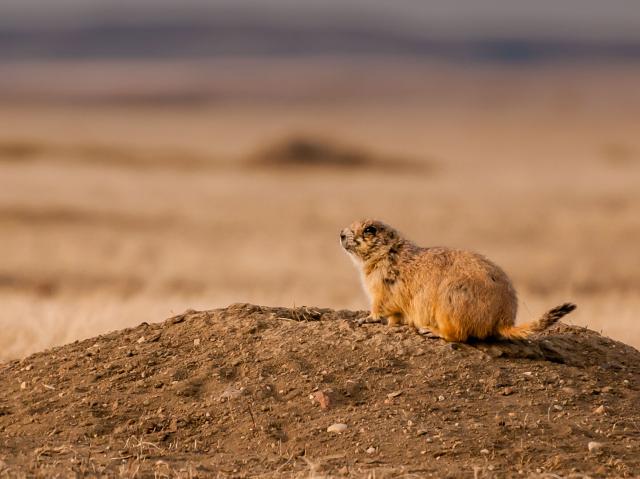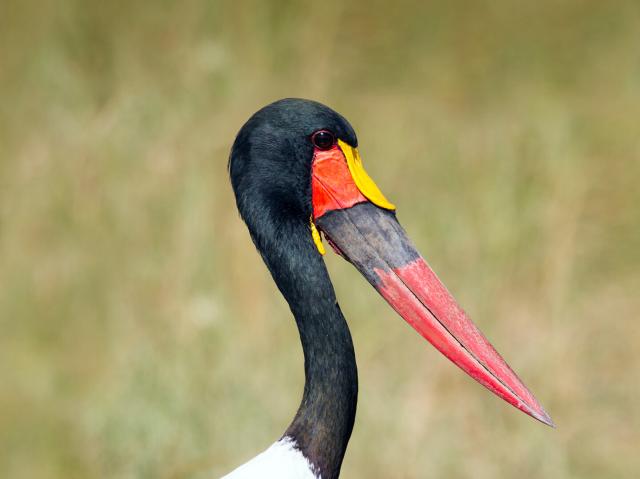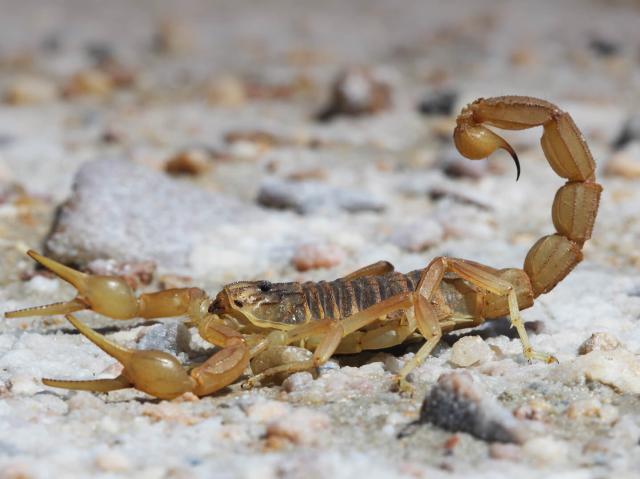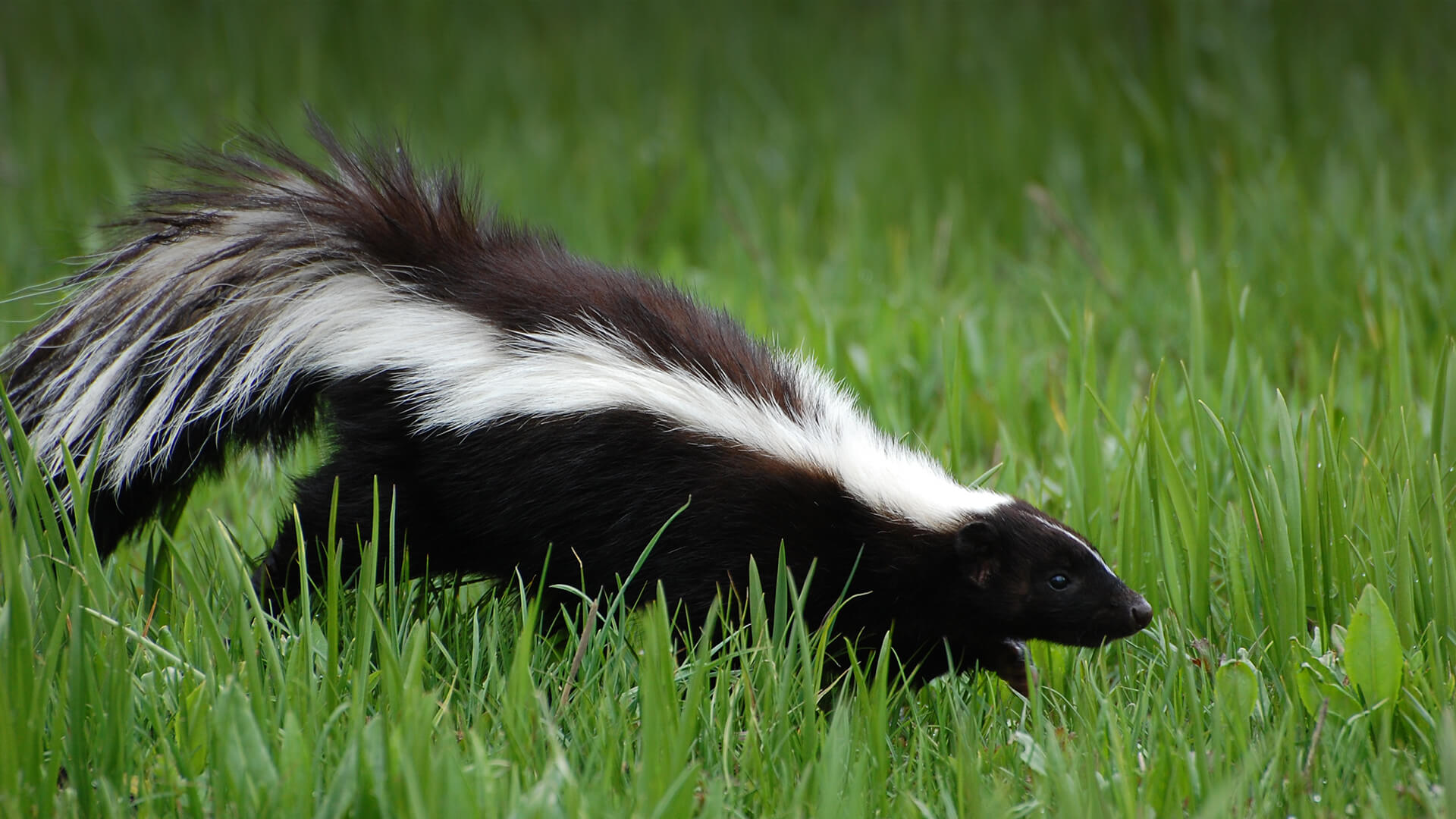
Striped Skunk

- Class: Mammalia
- Order: Carnivora
- Family: Mephitidae
- Genus: Mephitis
- Species: mephitis

ABOUT
Whether striped, spotted, hog-nosed, or hooded, these nocturnal creatures will likely stop you in your tracks. Skunks have “trained” just about all the wildlife in their habitat—except domesticated dogs!—to steer clear of them, due to their potential for dousing perceived threats in a lingering, noxious odor. While the striped skunk, with its dramatic white V of fur from its head down its body, may be the most well-known, there are nine more skunk species in this family (Conepatus, Mephitis, Spilogale), as well as two stink badger species (Mydaus) inhabiting Asia. There is considerable variation in coat pattern among them, but they have a great deal in common, including their debilitating olfactory abilities. This page will concentrate on the striped skunk.
I know you. Skunks, as a group, inhabit North America and South America (their Old World relatives are the aptly named stink badgers). Striped skunks are about the size of house cats, with small triangular-shaped heads, small ears, and dark eyes. Most of its fur is black, with a dazzling white stripe that starts at its head and splits into a wide V-shape at its rump. It also has a white bar on its forehead, between its eyes. Its bushy, black tail with some white “highlights” is about half the length of its body. Skunks are born with their stripes even before their fur grows in! However, the fur pattern varies across its vast range, from completely white or completely black. Striped skunks closely resemble hooded skunks, confounding researchers trying to study them.
Striped skunks have short, stocky legs with five toes on each foot. Their body size fluctuates throughout the year, as they may lose up to half their body weight while holed up during the cold winter months. Males are usually a bit larger than females.
Scent bomb: mist or stream. Despite the skunk’s well-known stinky strategy, plenty of predators would kill to feast on this black and white creature. In response to threats, skunks first try to escape, and if that’s not possible, they hiss and stamp their feet. That’s the interloper’s cue to escape. If the threat persists, a skunk can position itself in a U-shape so that its front and back ends are facing the trouble—which ensures the spray will hit the mark, without getting a drop on itself. If it is being chased and cannot see the predator, the skunk emits an atomized cloud of stench that the chaser must run through. This “shot gun” approach deters most predators.
When push comes to shove, it is one of the most effective defense mechanisms known. Spewing an oily, yellowish liquid produced by anal glands under its fluffy tail is a stroke of evolutionary genius. This legendary tactic leaves no permanent damage to its victims, but the stench may linger for days and the horrifying memory of the smell lasts much, much longer. One of the noxious ingredients makes it somewhat waterproof, so bathing has little effect on ridding the victim of the stench.
Solution. While the noxious “thiols” in skunk spray may persist for days, here is one recipe for a solution to oxidize the offending smell on people or pets:
Add one quarter cup of cup of baking soda to one quart of three-percent hydrogen peroxide and one teaspoon of liquid shampoo (or pet shampoo). Mix ingredients, and quickly apply while still foaming. Let stand for about five minutes, then rinse. The oxygen released by the foaming neutralizes the ungodly smell, and the detergent removes the oily part that holds the thiols in fur or skin. Then, pour yourself a glass of tomato juice and enjoy the fresh air!
HABITAT AND DIET
Just about anywhere! Striped skunks make a living throughout North America, from southern Canada into northern Mexico. They are quite at home in a variety of landscapes, from wooded areas to grasslands and agriculture fields, and even in urban areas, among humans. They may be found in open, exposed areas, though they seek cover in brushy, weedy stream and gulch bottoms or canyons. Pasture, farmland, and hay crops, especially along fence lines, are also utilized. According to the Smithsonian’s National Zoo, striped skunks do best at elevations below 5,900 feet (1,800 meters). While they do not hibernate, skunks in northern latitudes may lapse into a state of torpor during cold snaps or when the snow is deep.
Good cover and abundant food make for a suitable home range, and they avoid crossing busy roads, which may confine some home ranges. Where resources are plentiful, striped skunks have smaller home ranges. In northern climes, they travel far less in the winter. Researchers have noted home ranges anywhere from 0.31 to 7.4 square miles (0.5 to 12 square kilometers). Striped skunks are seldom found far from water sources, indicating that they need to drink regularly. When swimming, which is an uncommon event, they keep their head and tail above water and paddle to shore, eating fish and crustaceans if they happen upon them.
Home again. Skunks nest in burrows made by other wildlife, like marmots or badgers. They also take refuge under logs, in hollowed out trees, in rock or brush piles, and under buildings. They may dig their own den, if necessary. Female skunks are clever enough to den under fence lines, where they are safe from farm machinery. In winter, females may share a communal den to stay warm. Skunks may even seek shelter under your house. As long as your pet doesn’t frighten the skunk, your garden will benefit from its voracious omnivorous appetite!
Midnight at the oasis. Skunks are crepuscular and nocturnal. They head out in search of food, while watching out for a laundry list of predators, including humans, coyotes, domestic dogs, red foxes, lynx, bobcats, badgers, mountain lions, and fishers. Aerial predators include eagles, great horned owls, crows, and vultures (who feed on skunks after they’re dead). Between copious predators and a host of diseases including canine distemper and West Nile Virus, among many others, and the fact that skunks harbor numerous ectoparasites and endoparasites—including fleas, ticks, and lice—it’s no wonder they typically die young. In fact, a large percentage of skunks in any population consists of the young of the year. They rarely perish of old age.
That said, skunks are a resilient lot, flexible in habit and diet, and not afraid to shack up next to humans.
How do you like your eggs? Nocturnal, flexible opportunistic feeders that are not picky, skunks enjoy seasonal insects in the spring and summer—crickets, beetles, grasshoppers and other arthropods. They are also voracious consumers of bird eggs, so the progeny of ground-nesting birds suffer mightily at the jaws of skunks (and raccoons). Skunks use long foreclaws to dig insects and grubs out of logs, as well as your garden.
Its diet shifts to meat in fall and winter, with small mammals, ground-nesting hatchlings, as well as fish, reptiles, and amphibians on the menu. They will happily devour any pet food left outside, too. As the editors of Handbook of the Mammals of the World declared, “With the exception of lima beans, they will eat just about anything.” Skunks are awesome opportunistic omnivores!
In zoos, they feast on leafy greens, veggies, and insects as mainstays, with mice, eggs, nuts, and fruits to round out their cuisine.
FAMILY LIFE
Hear this! Skunks have a straightforward “vocabulary.” They mostly ignore each other (except during the breeding season) and other wildlife, but they can make a variety of sounds from low growls to chirps. When a skunk feels threatened, its first line of defense is to avoid conflict. If it cannot get away, it has a series of displays—hissing, foot stomping, arching its back, tail raising, and even a handstand—before resorting to its signature odiferous spray.
Kit and caboodle. Females are in estrus about 10 days, with breeding occurring from February through March; young are born starting in April, and can continue through June. Breeding early in the season may cause females to undergo a short period of delayed implantation. Males will try to mate with several females. Skunks are “induced ovulators,” meaning the act of copulation causes the ovaries to release the eggs. When a female is pregnant, she may become aggressive toward male skunks. Once the litter is born, she may kill her kits if threatened, so steer clear!
Kits are born helpless and completely reliant on their mother. They are toothless, with eyes and ears sealed shut. The kits’ eyes open at about three weeks of age and weaning occurs by eight weeks of age, when they will accompany their mother on nighttime foraging expeditions, usually single file behind her. They waddle along looking, sniffing, and listening for insects and other small prey. By early fall, the youngsters disperse. Few skunks survive their first year, but those that do fill an important and dynamic niche throughout their habitat.
CONSERVATION
Like most skunk species, striped skunks are considered at low risk of extinction throughout their range. The only skunk species that is listed as Vulnerable on the International Union for Conservation of Nature (IUCN) Red List of Threatened Species is the pygmy spotted skunk of western Mexico, which has lost about 30 percent of its population over the past several years. Hopefully, as people learn more about skunks, they will appreciate these hardy, nocturnal omnivores and the important roles they fill in the landscape.
By supporting San Diego Zoo Wildlife Alliance, you are our ally in saving and protecting wildlife worldwide.


